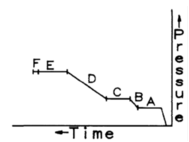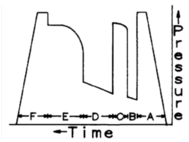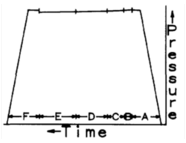

Drill Stem Testing has been the industry’s choice for well testing purposes for years. Improve your reservoir characterization with WellMax DST and get accurate downhole measurements from hostile environments. Our improved tool operation gives you flexibility to test your wells accurately and in most economical way by saving your operational cost.
A DST is a systematic procedure for evaluating the hydrocarbon potential of a reservoir. This test is a valuable and cost-effective test that is mainly employed in exploratory wells. The main objective of the test is to study the reservoir characteristics as well as evaluate the commercial viability of a zone’s economic potential by identifying productive capacity, pressure, permeability or extent of an oil or gas reservoir."
Improve your reservoir measurement and testing during exploration or development with WellMax OT portfolio of Drill stem Testing (DST) and Tubing Conveyed Perforation (TCP).
WellMax is committed to Safety and Service delivery to our clients and hence we provide a range of downhole tools and measurement gauges to safely flow the hydrocarbon to surface and measure the downhole temperature and pressure.
DST tools with 10,000 psi differential and 5” OD, 2.25” ID,suitable for performing DST operations in 7” and 9-5/8 Casing.
Packer- To provide isolation between Formation and Annulus, high integrity packers also act as well barrier element.
WellMax provides Mechanically Set retrievable packers for 7” and 9-5/8” casing, Our Packers have inbuilt “Hold Down” section to prevent pump out.
WellMax Packers can sustain severe downhole conditions of 10,000 psi differential, 300F For more information, please see the data sheet or contact us
JAR- Jarring is required often in downhole testing operations when string can’t be set free normally. Drilling Jars are not fit for purpose to be run in DST String hence WellMax provides JAR which can be run in tandem with WellMax Packer. Jar is operated by string pull and provides a upward shock to the string which sets the stuck string free.
10,000 psi differential, 300FFor more information, please see the data sheet or contact us
Safety Joint- Safety Joint enables to back off the string at Safety Joint and retrieve the gauges and other components of DST string. Safety Joint is run with Packer and can be easily backed off when required by rotating the string anti-clock wise. After retrieving the upper string the left in hole BHA can be retrieved by using drilling jar.
10,000 psi differential, 300FFor more information, please see the data sheet or contact us
Tester Valve- WellMax provides very reliable Annulus operated Tester Valve.
Tester Valve can be cycled open/close multiple time as required for downhole Build-Up and Flow Study.
Tester Valve is used to isolate the well formation and cushion to create required underbalance in the well. Using Tester valve reduces the wellbore storage effects,
Tester Valve acts as a well barrier element as well. Rated to 10,000 psi differential, 300F For more information, please see the data sheet or contact us
Flapper Safety Valve- Flapper safety Valve is a reliable safety valve activated by annulus pressure. Until activated it acts as an open pipe however after activating it hold pressure from below but allows pump through from top. This enable easy well killing/ bull heading after activating the flapper valve. It also acts as a secondary well barrier elements incase primary well barrier in string fails. Rated to 10,000 psi differential, 300FFor more information, please see the data sheet or contact us
Muticycle Reversing/Circulating Valve- WellMax provides a multicycle Reversing/circulating valve which enable easy spotting of cushion or simulation fluid to its depth. It also can be used for reversing out string fluid replaced by kill fluid in order to safely kill the well. Rated to 10,000 psi differential, 300FFor more information, please see the data sheet or contact us
Reversing Valve- WellMax provides an annulus operated single operation reversing valve which is used for reverse or direct circulation of the fluid in/ out of the string. Reversing Valve is very important for well killing operation. Rated to 10,000 psi differential, 300F For more information, please see the data sheet or contact us
Expansion joints- In Order to compensate the thermal expansion or contraction during flow, circulation or simulation activities during a well test, WellMax provides Expansion Joints. Typically each expansion joint can expand 5ft hence each tool can compensate 5 ft of Thermal Expansion or Contraction. Based on well depth, Bottom hole temperature & Surface temperature multiple expansion joints might be required. Rated to 10,000 psi differential, 300F For more information, please see the data sheet or contact us
Gauge Carrier- Downhole pressure and temperature measurements are the most important deliverable of any DST jobs, WellMax provide a Gauge Carrier which can carry 4 gauges at time. Gauge Carriercan be run in tandem with DST string, usually below Tester Valve in order to get downhole build up data.
Rated to 10,000 psi differential, 300FFor more information, please see the data sheet or contact us
Downhole Memory Gauges- WellMax provide high resolution memory gauges which can record downhole pressure and temperature with high frequency for long durations. Depending on the well conditions and requirement mechanical or electronics gauges can be used. Usually Memory Gauges are ran in downhole gauge carrier however where required a wireline or slick can be used to convey the memory gauges in the well. Rated to 10,000 psi differential, 300F For more information, please see the data sheet or contact us
Below are proven charts that depict the pressure graph with respect to time during different situations in DST.
Case#1.
This is a perfect chart. The pressure gauge is located inside but above the closing tool.

Here,
A= addition of cushion or run in a hole
B= initial hydrocarbon flow period
C= initial shut-in period
D= final hydrocarbon flow period
E= final shut-in period
F= pullout of pressure gauge from hole
Case#2.
This represents a perfect chart. The pressure gauges are located inside above and outside below the closing tool. They help in analyzing transient pressure.

Here,
A= run in a hole
B= initial hydrocarbon flow period
C= initial pressure buildup
D= final hydrocarbon flow period
E= final pressure buildup
F= release of packer and pulling it out of hole
Case#3.
This represents a perfect chart. The pressure gauge is placed below the bottom packer on a straddle test.

A= run in a hole
B= initial hydrocarbon flow period
C= initial pressure buildup
D= final hydrocarbon flow period
E= final pressure buildup
F= pulling packer out of hole